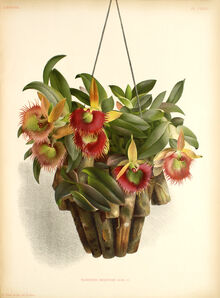| Epidendrum | ||||||||||||||||
|---|---|---|---|---|---|---|---|---|---|---|---|---|---|---|---|---|
|
| ||||||||||||||||
| ||||||||||||||||
Epidendrum, abbreviated Epi in horticultural trade, is a large neotropical genus of the orchid family
Distribution[]
They are native to the tropics and subtropical regions of the American continent, from South Carolina to Argentina. Their habitat is mostly epiphytic, a few are terrestrial or rarely growing on bare rock, such as Epidendrum calanthum and Epidendrum saxatile. Most are to be found in the Andes, at altitudes between 1,000 and 3,000 m. Their habitat varies from humid jungles to dry tropical forests, from sunny grassy slopes to cool cloud forests.
Description[]
They are very varied in flower size and appearance. They grow in tufts, in racemose inflorescences, sometimes in corymbs or panicles. The apical, lateral or basal flowers are mostly small to medium in size and are not marked by a conspicuous display. They are borne on a dense inflorescence. Many species are fragrant. The flowers may be produced only once, or during several years from the same or new racemes. The ellipsoid fruits are 3-ribbed capsules.
This genus has the following characteristics :
- a slit rostellum (small extension or little beak to the median stigma lobe), giving a transparent or white thick and adhesive liquid.
- the fringed lip is adnate to ( = united with) the column (forming a nectary tube (but rarely producing nactar), continuing through the pedicel).
- the pollinarium contains 4 pollinia (with sometimes 2 very reduced pollinia), rarely only 2 pollinia.
- the erect stems are reed-like, simple or branching, but can also contain pseudobulbs or thickened stems.
Culture[]
Grow plants in cool to warm temperatures in partial shade. Plants should be grown in a mixture of fine bark with perlite. Plants can also be potted in New Zealand sphagnum moss or tree fern fibers. Keep the potting mix moist but not wet or damp. Water when the mix begins to dry. To induce blooming keep plants cool.
In Auckland and other sub-tropical regions of New Zealand, the cool growing plants will flower all year round. While they are normally grown in pots, it is also possible to grow them in a bark garden.
Taxonomy[]
When Carolus Linnaeus named this genus in 1763, he included in this genus all the epiphytic orchids known to him. However, few of these orchids are still included in the genus Epidendrum.
More than 1,000 have been split off into new genera such as Barkeria, Dimerandra, Encyclia, Oerstedella, Psichylus and Nanodes. However, it is estimated that there are more than 2,000 Epidendrum orchids, many of which still have to be discovered. More than 400 new species have lately been described by Eric Hágsater and colleagues.
Naming[]
The genus name (from Greek, "growing on trees") refers to its epiphytic growth habit. It is also commonly known as the star orchid or crucifix orchid. With more than 1,100 species, some authors refer to it as a mega-genus.
Synonyms[]
- Amphiglottis Salisb. 1812
- Anacheilium Hoffmannsegg 1842
- Auliza Sm. 1913
- Aulizeum Lindley ex Stein 1892
- Coilostylis Raf. 1836[1838]
- Dinema Lindley 1831
- Hormidium Lindley ex Heynth. 1841
- Kalopternix Garay & Dunst. 1976
- Larnandra Raf. 1825
- Nanodes Lindley 1832
- Neolehmannia Krnzl. 1899
- Nychosma Raf. 1836
- Nyctosma Raf. 1836[1837]
- Phaedrosanthus Neck. 1903[1904]
- Prosthechea Kn. & Westc. 1838
- Pseudepidendrum Rchb.f 1852
- Stenoglossum H.B.K. 1816
Species[]
Natural Hybrids[]
- Epidendrum × doroteae P.H.Allen (1958)
- Epidendrum × gransabanense Carnevali & I.Ramírez (2003) = (Epidendrum ibaguense × Epidendrum secundum)
- Epidendrum × monteverdense Pupulin & Hágsater) Hágsater (2005) = (Epidendrum endresii × Epidendrum exasperata)
- Epidendrum × purpureum Barb.Rodr. (1877) = (Epidendrum denticulatum × Epidendrum myrmecophorum)
References[]
| This page uses Creative Commons Licensed content from Wikipedia (view authors). | 
|
- Hagsater, E., Sanchez Saldana, L., and Garcia Cruz, J. (eds.) 1999. Icones Orchidacearum: fascicle 3. The genus Epidendrum: part 2. "A second century of new species in Epidendrum". Herbario AMO, Mexico D.F.
- Hagsater, E. 2001. Icones Orchidacearum: Fascicle 4. The Genus Epidendrum. Part 3, "A Third Century of New Species in Epidendrum". Asociacion Mexicana de Orquideologia A.C., Mexico, D.F.
- Hágsater, E. 2004. The genus Epidendrum. Part 4. A fourth century of new species in Epidendrum. Icon. Orchid. 7: pl. 701-800.
